Oxidation Number method (also called Oxidation State method) provides relatively an easy way to balance redox (including ionic redox) equations. The underline principle is that the gain in the oxidation number (number of electrons) in one reactant must equal to the loss in the oxidation number of the other reactant (Conservation of Electrons). The procedure is outlined below.
Chemical equations can be balanced using oxidation numbers of the species involved. This module can guide you through step-by-step in balancing redox reactions using this method. Here are the steps:
Assign oxidation numbers to all atoms
Identify oxidized and reduced species
Compute electrons lost (oxidation) and gained (reduction)
For reactions in acidic or basic solution, add H+/H2O (acidic) or OH-/H2O (basic) to balance the charges.
Multiply these by appropriate factors make electrons lost = electrons gained
Complete the equation by final inspection.
The Wizard for Oxidation Number Method walks through step-by-step in balancing an equation with detailed guide side-by-side. The example shown below is for the reaction in acidic media. The similar procedure applies to the basic or neutral media.
1. Open the Balance Equation module and enter the unbalanced equation.
Here is the typing instruction:
To enter normal text, just type in as is, be sure to use both cases for element symbols, e.g. Fe (Not FE). Be sure the Input Option - Normal is selected (default).
To enter the equation sign, you can use either "=" or "--->"or "<--->" symbols.
To enter superscripts for the charge species (Ca2+), there are two ways to input them:
Option 1: Select Superscript in the Input Option and type in ONE character, the option selection will return back to Normal. Click Superscript again, and enter the second superscript character. For example, the keystroke sequence to enter Ca2+ is C-a-"Superscript"-2-"Superscript"-"+".
Option 2: Press UpArrow key, the enter a superscript character, if needed, press UpArrow key again and then type in the second superscript character. For example, the keystroke sequence to enter Ca2+ is C-a-UpArrow-2-UpArrow-"+".
To enter subscripts for atom counters (H2), follow the similar instructions above, but use Subscript option box or DownArrow.
To enter a hydrated compound (CuSO4•5H2O), type in "." (period). The period (.) will be converted to the dot symbol(•) automatically upon typing in.

2. Upon entering the equation, click Wizard to start the Equation Wizards. The Wizard selection screen appears. There are four wizards you can select. In this case, click on Oxidation Number Method.
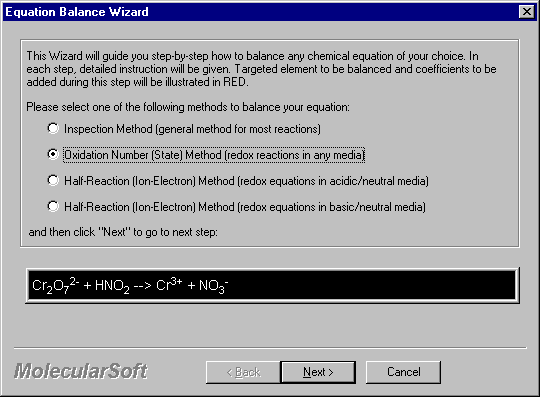
3. Click Next to proceed. The first screen of the Oxidation Number wizard appears.
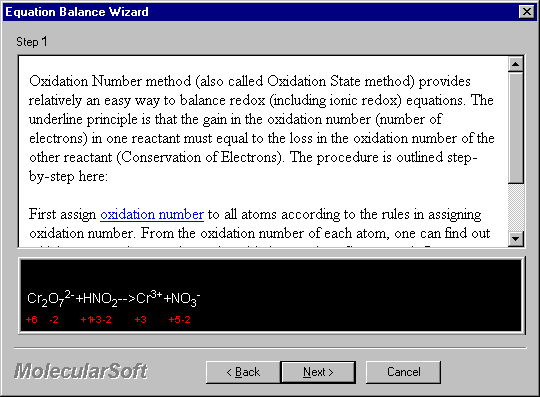
First assign Oxidation Number to all atoms according to the rules in assigning oxidation number. From the oxidation number of each atom, one can find out which atoms undergo a change in oxidation number. See example:
4. Click Next.
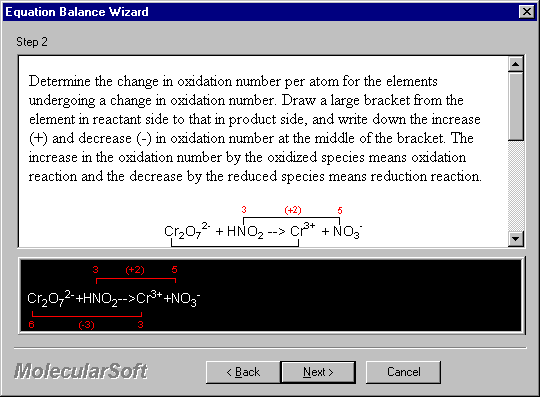
Determine the change in oxidation number per atom for the elements undergoing a change in oxidation number. Draw a large bracket from the element in reactant side to that in product side, and write down the increase (+) and decrease (-) in oxidation number at the middle of the bracket. The increase in the oxidation number by the oxidized species means oxidation reaction and the decrease by the reduced species means reduction reaction.
In the case of Disproportionation Reaction, where the same element is both oxidized and reduced, such species is written twice on its side. See Example II here.
5. Click Next.
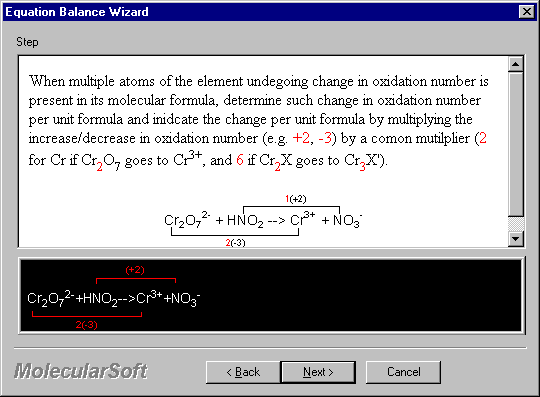
When multiple atoms of the element undergoing change in oxidation number is present in its molecular formula, determine such change in oxidation number per unit formula and indicate the change per unit formula by multiplying the increase/decrease in oxidation number (e.g. +2, -3) by a common multiplier (2 for Cr if Cr2O7 goes to Cr3+, and 6 if Cr2X goes to Cr3X').
6. Click Next.
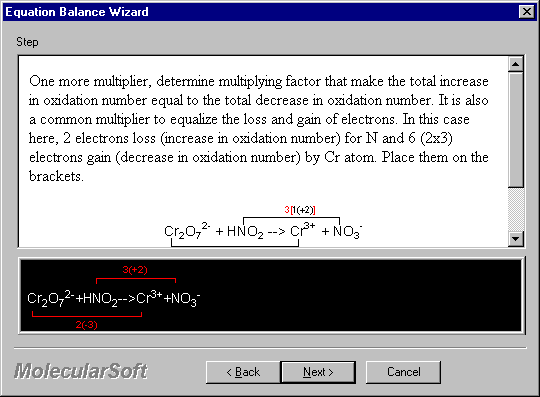
One more multiplier, determine multiplying factor that make the total increase in oxidation number equal to the total decrease in oxidation number. It is also a common multiplier to equalize the loss and gain of electrons. In this case here, 2 electrons loss (increase in oxidation number) for N and 6 (2x3) electrons gain (decrease in oxidation number) by Cr atom. Place them on the brackets.
7. Click Next.
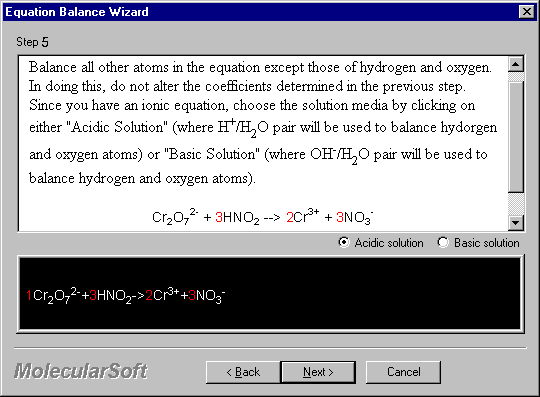
Balance all other atoms in the equation except those of hydrogen and oxygen. In doing this, do not alter the coefficients determined in the previous step. Since you have an ionic equation, choose the solution media by clicking on either Acidic Solution (where H+/H2O pair will be used to balance hydrogen and oxygen atoms) or Basic Solution (where OH-/H2O pair will be used to balance hydrogen and oxygen atoms).
Click on Acidic solution check box in this case.
8. Click Next.
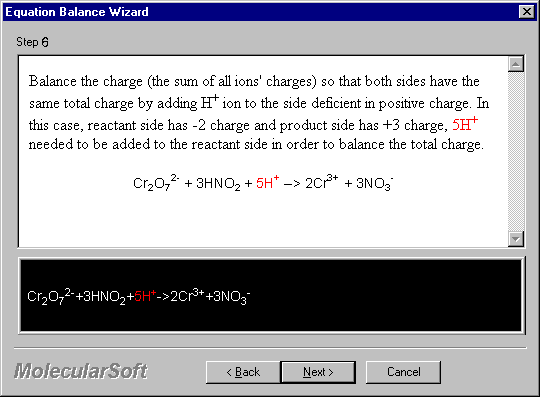
Balance the charge (the sum of all ions' charges) so that both sides have the same total charge by adding H+ ion to the side deficient in positive charge. In this case, reactant side has -2 charge and product side has +3 charge, 5H+ needed to be added to the reactant side in order to balance the total charge.
9. Click Next.
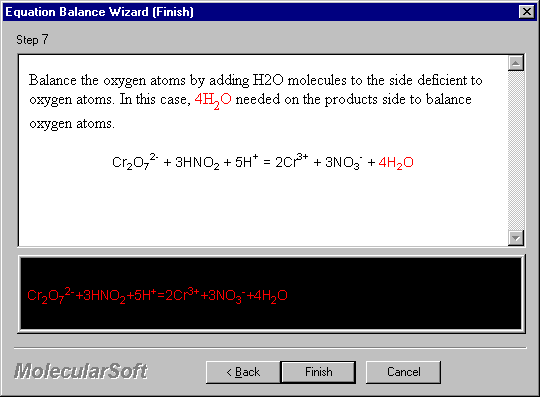
Balance the oxygen atoms by adding H2O molecules to the side deficient to oxygen atoms. In this case, 4H2O needed on the products side to balance oxygen atoms.
10. Click Finish. The wizard walk-through is finished and it returns to the Equation Balance main screen with the balanced equation displayed.
